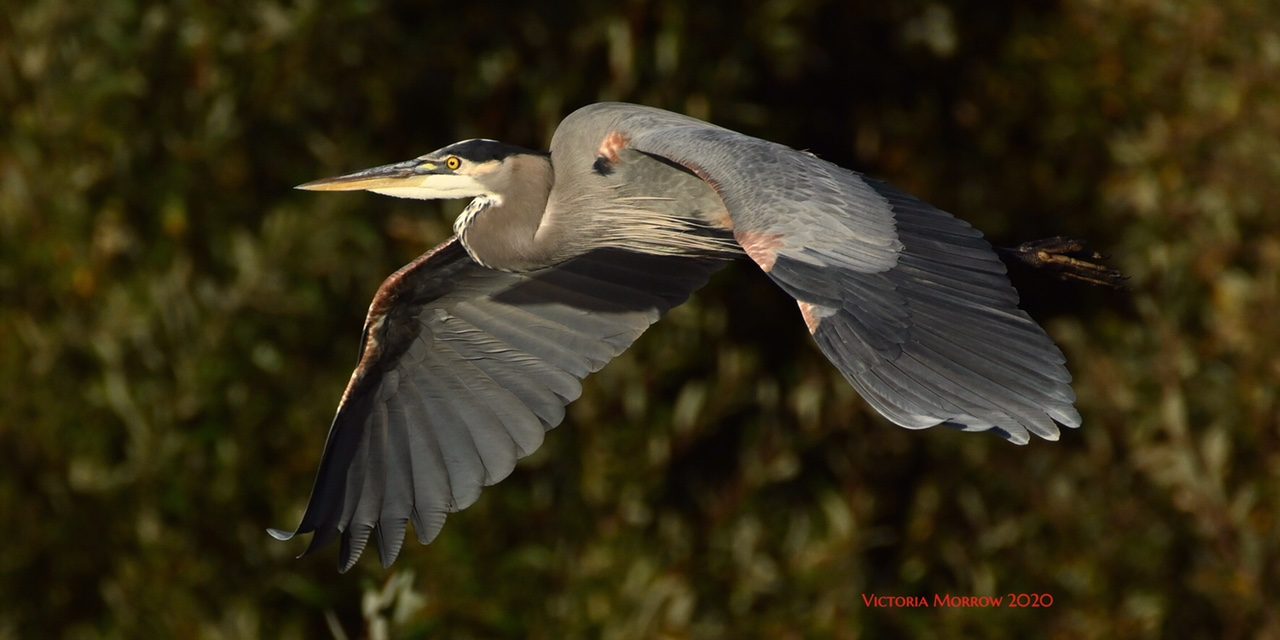Avila Beach may have a shortage of parking spaces, but there is certainly no shortage of birds. Many magnificent, winged creatures can be seen while glancing in just about every direction. Some are tiny, like Anna’s hummingbird and others are much grander in size. One particularly interesting, feathered friend is the majestic Great Blue Heron (Ardea herodias).
Great Blue Herons are particularly noticeable while venturing on the aptly named Blue Heron Drive, which is the wider road section of the Bob Jones Pathway.
The well-groomed blue-gray plumage is a luxurious sight. Most often, the tall, long-necked birds are seen wading along the edges of the estuary or hunting on the nearby grassland.
A Great Blue Heron is quite fascinating to observe. Its statuesque stance resembles a Tai chi posture. The heron often stands motionless for a period as it scans for prey.
When it does move, it takes long, slow, deliberate steps. The moves are serenely gentle until it strikes with lightning-speed accuracy.
Their strong dagger-like bill allows them to successfully hunt both in water and on land. They are equipped with a specially designed neck vertebrae that allow the heron to impale their target quickly and precisely at a distance. Regardless of its narrow neck, herons swallow their victim whole and gulp it down their flexible esophagus and into their loose stretchable stomachs. Their diet is primarily fish but includes amphibians, reptiles, small mammals, insects, and other birds. An adult heron easily consumes up to a pound of fish per day. However, herons are opportunists and can snatch a gopher or other small rodent for a meal. That is a surprisingly big mouthful! Hence, no fishing required. The neck, sharp beak, and long legs of the Great Blue Heron allow them to be astonishing hunters.
A heron’s height can range from 3½’ to 4½’, but despite their size, it is a lightweight, weighing in at only 5-6 pounds. Keep in mind, like most birds; their bones are hollow. It is not unusual to see a Great Blue Heron perfectly balanced atop a floating bed of kelp. That allows for a great vantage point to snap up a fish swimming by. Herons can hunt both day and night. They are equipped with a high percentage of rod-type photoreceptors in their eyes that greatly improve night vision. Surprisingly, they sleep at night in trees, which keeps them from becoming fair game.
While traveling on the Bob Jones Trail, you often can view the graceful Great Blue Heron in flight.
Their sweeping wingspan is about 6 feet. They fly seemingly effortlessly at speeds between 20-30 miles per hour. The heron folds its neck into an “S” shape as its legs trail behind. A heron will efficiently dangle its legs when preparing to land like a jet lowering wheels for a landing. Herons display such elegant moves.
During the nesting periods, which normally peak at the end of March, treetop colonies, which are called a heronry, are busy with activity. Herons are most vocal on the breeding grounds; loud, deep squawks are easily heard. Herons group for nesting, which helps protect their young from predators. Their large bulky nest of sticks can be seen in the tall eucalyptus trees that grow along the Bob Jones Pathway near the golf course. A nest can be 4’ across and up to 4’ deep.
Most of the time, nests are used year after year, but Great Blue Herons do not necessarily return to the same nest nor choose the same mate. The nest is built mostly by the female, with the male gathering and presenting most of the required material to the female. It is amazing to see a heron flying with a sizable stick heading towards the nesting grounds. The clutch size is usually 2-6 eggs, but typically only 1 or 2 young will survive.
Herons are legally protected by the Migratory Bird Treaty Act. They are dependent on wetlands for feeding and breeding. The beautifully designed avians are vulnerable to habitat loss and impacts such as traffic, logging, motorboats, and other human intrusions that can disrupt nesting colonies. Chemical pollutants and other causes of water quality are also a threat. Concerningly, local observers have noted a decline in the Great Blue Herons recently in our area. The nesting activity seems significantly reduced this year.
Responsibly, we should question why that has occurred and look for ways to amend the situation. Protecting the wildlife environment is of great importance for the survival of all waterfowl. The Great Blue Heron is no exception. Let us continue to have a healthy heron population roosting in Avila’s towering trees.








